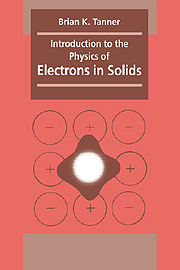Book contents
- Frontmatter
- Contents
- Preface
- Acknowledgements
- 1 The classical free electron model
- 2 Quantum mechanical free electron model
- 3 Application of the Fermi gas model
- 4 Energy bands
- 5 Experimental evidence for band structure and effective mass
- 6 Electrical conduction in semiconductors and insulators
- 7 Semiconductor devices
- 8 Localized electrons
- 9 Magnetism
- 10 Superconductivity
- Appendix 1 Elements of kinetic theory
- Appendix 2 Elements of statistical mechanics
- Appendix 3 Derivation of the Landé g factor
- Index
1 - The classical free electron model
Published online by Cambridge University Press: 05 June 2012
- Frontmatter
- Contents
- Preface
- Acknowledgements
- 1 The classical free electron model
- 2 Quantum mechanical free electron model
- 3 Application of the Fermi gas model
- 4 Energy bands
- 5 Experimental evidence for band structure and effective mass
- 6 Electrical conduction in semiconductors and insulators
- 7 Semiconductor devices
- 8 Localized electrons
- 9 Magnetism
- 10 Superconductivity
- Appendix 1 Elements of kinetic theory
- Appendix 2 Elements of statistical mechanics
- Appendix 3 Derivation of the Landé g factor
- Index
Summary
In practical terms, the enormous range of values of resistivity of solids is something which we take for granted. Every day, we happily touch the polymer sleeving or fitments surrounding conductors bearing potentially lethal currents at quite high voltages. Only when one is reminded that the difference of almost 30 orders of magnitude found between the resistivity of the noble metals and some synthetic polymers represents the largest variation of any physical parameter does this apparently mundane phenomenon suddenly appear intriguing. It is tempting to enquire whether the same physical process can be responsible for electrical conduction in all materials. Even if the same process extends over half the range it would be a remarkable achievement. Perhaps we would then appreciate why so much time and effort is devoted to measurements of electrical conductivity.
It is hard to conceive that, prior to the turn of the century, very little was known about the physics of solids. Some ideas on crystal structure had been anticipated from the morphology of natural and synthetic crystals but there existed little understanding of the electrical, thermal or magnetic properties of solids. Solid state physics is a twentieth century branch of science and as such deserves recognition as an important section of ‘modern physics’. As we shall see later, it was not until quantum mechanics was applied to the physics of solids that many real advances were made.
- Type
- Chapter
- Information
- Introduction to the Physics of Electrons in Solids , pp. 1 - 18Publisher: Cambridge University PressPrint publication year: 1995

